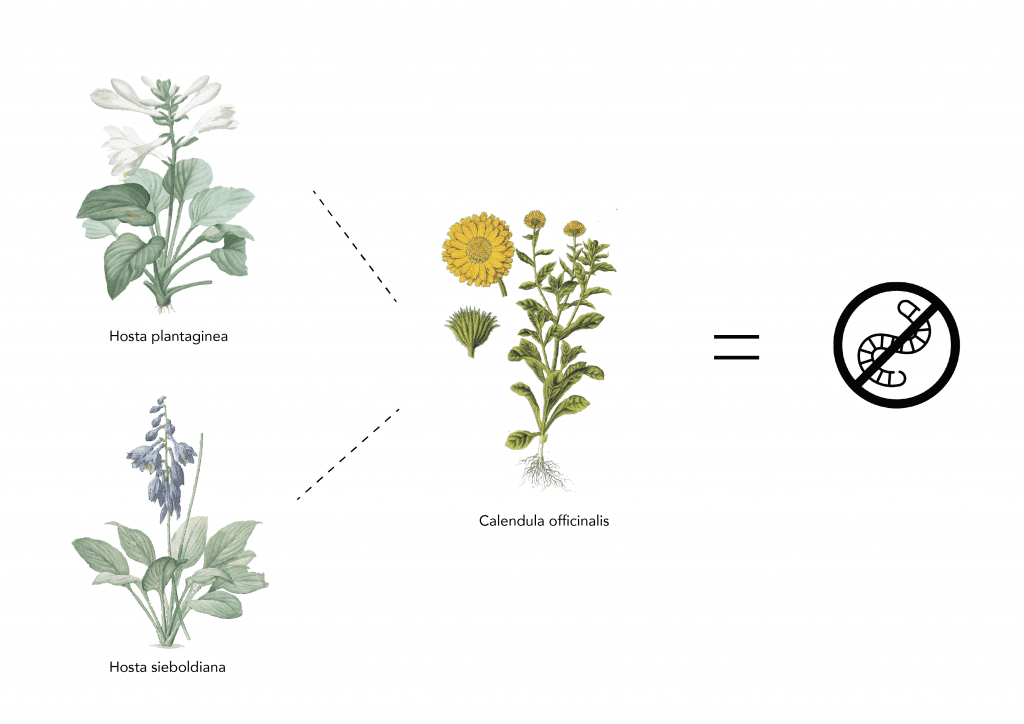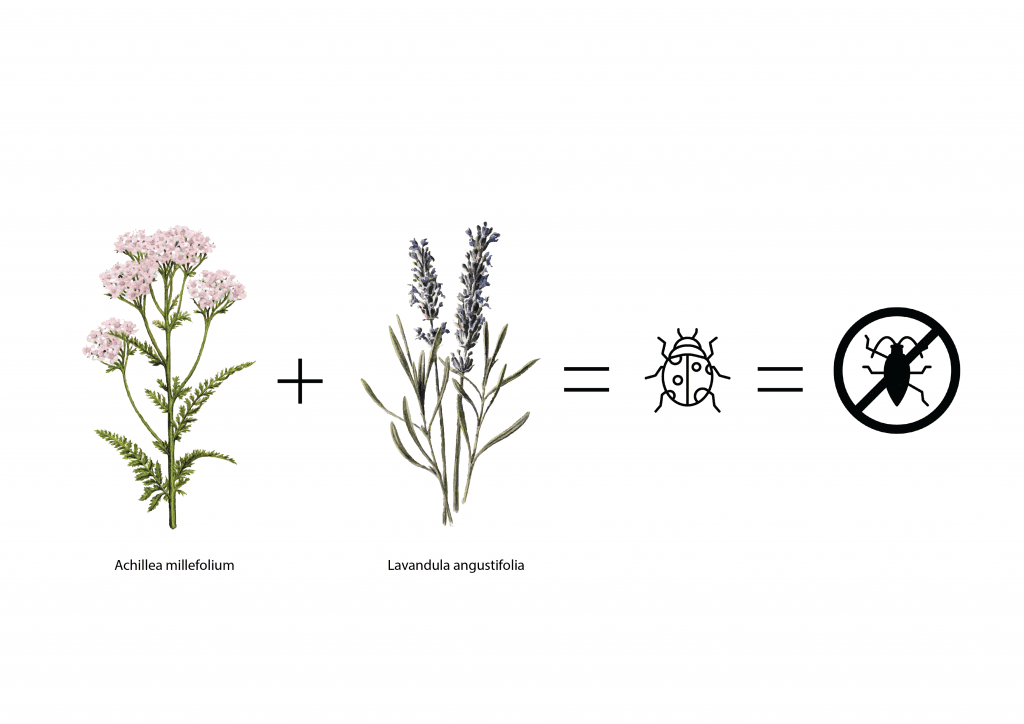

25 Jun Companion Planting: Enhancing Green Spaces with Plant Synergy
Author: Eirini Trachana
Keywords: Companion planting, biophilic design, urban greenery, plant interactions, sustainable landscaping, native plants, plant communication, ecological design, biodiversity, beneficial insects
Introduction
Companion planting is a time-honored technique that has been traditionally used in agriculture to maximize production, but it is now being explored as a potential innovative solution to enhance green spaces in urban environments. This type of planting involves strategic combinations of plants in shared environments which can result in improved soil health, pest deterrent, and attraction of beneficial insects. The technique can ensure that urban landscapes are visually appealing, resilient, and self-sustaining. This holistic approach reduces the need for chemical interventions, promoting a healthier environment for both plants and urban dwellers—an invaluable insight because urban design often deals with limited space in which plant health is paramount but volatile. This blog delves into companion planting, focusing on its potential to change urban greenery by promoting plant health, biodiversity, and ecological resilience, ultimately creating a more sustainable as well as aesthetically pleasing environment, which is the ongoing mission at Makers of Sustainable Spaces.
Background
In a recent study published by the Royal Entomological Society, researchers used a combination of conventional researcher-led experiments and observational citizen scientist data, to test the effectiveness of the bee-friendly borage plant (Borago officinalis) as a companion plant to strawberry (Fragaria x ananassa). Strawberries collected during the experiment were also subject to fruit measurements and assessments of market quality. In the end, companion plants were found to significantly increase both the yield and market quality of strawberries, which suggested an increase in insect pollination per plant. Strawberries companion-planted with borage produced an average of 35% more fruits, and 32% increased yield by weight. Test strawberry plants produced significantly more fruit of higher aesthetic quality when assessed by Marketing Standards for Strawberries.


With the indication that companion planting is an effective strategy to enhance the well-being of a plant, in this blog, we explore the practical applications of companion planting in urban green spaces. By leveraging plant interactions, we can explore how we can take a traditional agricultural technique and apply it to biophilic urban design to help a plant achieve its full potential. To answer this question, we must first recognize the goals of an urban green designer— to ensure both client and plant satisfaction, as the two are mutually reinforcing. This article will explore how companion planting supports this in the following sections:
Part I: Client Satisfaction
- Ensuring the aesthetic quality of a design
- Ensuring the sustainability of a design
Park II: Plant Satisfaction
- Emphasizing root health
- Being aware of ‘spreaders’
- Combining to protect against pests
- Combining to attract beneficial insects
Part I: Ensuring Client Satisfaction
Ensuring the aesthetic quality of a design
As discussed in the blog “How to Design with Plants”, biophilic designers have aesthetic criteria when it comes to combining plants. A designer needs to consider the flow of a space, the environment surrounding the space, the atmosphere of a design, and accentual elements that will add novelty. All of these factors contribute to a functional and aesthetic design that satisfies the client. In all cases (whether or not companion planting is being used), a designer considers the specifications of the plants incorporated into the design, like the height, color, shape, seasonality, as well as the conditions where the plant thrives. As proven in the study referenced above, a plant can indeed thrive with a fellow companion plant. This initiates a domino-effect, as a thriving plant contributes to a lush, colorful atmosphere. Therefore, when mindfully executed, companion planting can help a designer set an effective aesthetic and even achieve some accentual elements. Companion planting can also inspire the inclusion of accents that otherwise would not have been considered, contributing to the surprising quality of the design. At MOSS we value aesthetic quality immensely, but designs are ineffective if they do not last, so the sustainability of the design is equally paramount.
Ensuring the longevity of a design
In addition to aesthetic criteria, we utilize criteria to keep the design sustainable and healthy, as easy longevity is key to client satisfaction. This includes considering the biodiversity, maintenance, and sustainability of the design:
- Biodiversity; We make sure that the design produces enough nectar to attract beneficial insects and small birds and enhance the biodiversity of the space.
- Maintenance; The species we select need to be either native or adapted to the conditions to keep maintenance as low as possible.
- Sustainability; We choose hardy species, suitable for the conditions in the different sites. That ensures the sustainability of the planting and lowers the plant replacement costs.
The ultimate goal and the reason we set all those criteria is to keep the plants happy because plant wellness eventually ensures both the aesthetics and the sustainability of the design. When combining mutually beneficial plants, we are improving the biodiversity of a design in a way that is proven to attract insects. Companion planting is also proven to reinforce the well-being of a plant, reducing maintenance requirements and improving its longevity. Thus, companion planting improves the aesthetic and keeps the design balanced and sustainable for the client’s satisfaction.


PARK II: ENSURING PLANT SATISFACTION


Emphasizing Root Health
Just like humans, plants need to communicate and interact to stay thriving. Research shows that plants communicate with each other through the roots in the way and the direction they spread. Roots use hormones and proteins to communicate internally with the rest of the plant in case there is a stressing factor in the environment, like drought, high temperatures, or shade. At the same time, plants use roots to warn their neighbors about possible stress factors or dangers, such as pests. Thus, the rooting system is a major aspect of plant health and communication with other organisms.
Companion planting is an incredibly effective way to reinforce and improve a plant rooting system, subsequently improving a plant’s ability to thrive. For example, mycorrhiza (a fungus) is often used as a natural fertilizer in indoor and outdoor planting. In reality, it is a beneficial fungus that works as the food transportation system of the soil. A single fungus’ mycelium can extend over a surface of 4 square miles, as in the case of the largest living being on earth. Plant roots can’t reach that far. A plant can trade the surplus of sugars produced by photosynthesis in exchange for increased access to water, nutrients, and protection from pathogens. When added to the substrate, it strengthens the root system and helps the plant to develop and absorb nutrients. This is an ultimate example of companionship between the fungus and the plants. Mycorrhiza can benefit both indoor and outdoor plants by expanding the plant’s root network and increasing both its nutrient and water uptake. Essentially, plants eat and drink better when they have friendly fungus helping them out!
Paying attention when using ‘spreaders’
The term ‘spreaders’ refers to plants that spread quickly, narrowing down the space of other plants. In some cases, these species are invasive, coming in from other ecosystems, and should be removed to preserve the existing ecosystem. However, in other cases, these are native species that simply reproduce rapidly. These native plants are beneficial biodiversity but should be used carefully because of their aggressive spreading rate.
There is a sensitive balance nesting within any planting scheme, a balance that companion planting can solidify or completely throw off. If a ‘spreader’ is combined with a plant with a ‘slow grower’ in a confined planter, this might lead to the ‘slow grower’ completely disappearing. An example of this is Persicaria bistorta, which is a species native to the Netherlands with high pollinating value. This plant produces nectar for two months at the beginning of summer and it attracts bees and butterflies. However, if it is placed on a rooftop design with other plants next to it, the other plants might struggle to develop and perform or they might even totally vanish. In conclusion, using ‘spreaders’ as companion plants should be done with care, and only in large landscapes where they will do more benefit than harm.


Combining to protect against pests
Most scientific research on companion planting is agriculturally oriented towards making plants more productive. But in addition to increasing productivity, companion plants can also assist each other in repelling pests and harmful insects. For example, thyme can be combined with strawberries to deter worms and insects that might harm strawberries. Additionally, it improves the soil and attracts pollinators which overall benefit the ecosystem. Furthermore, Thyme is widely used for its ornamental value, as it becomes a breathtaking purple carpet when it flowers. Strawberries can also be used ornamentally because the fruits attract small birds, contributing to biodiversity and movement of a design.
Another great combination in half-shaded ornamental borders is marigolds with hostas. Hostas are plants with stunning foliage, but at the same time, they are highly vulnerable to pests like slugs. Hostas need the help of marigolds (Calendula officinalis) which produce compounds that deter soil pests. In this combination, marigolds are annual plants, meaning they need to be replaced every year which increases the maintenance. Still, it is easier to add companion marigolds in the planter every year than to deal with damaged hostas. Additionally, the vivid flowers of marigolds attract pollinators, making the design more attractive and biodiverse.


Combining to attract beneficial insects
Another way to make sure that plantings stay pest-free is attracting beneficial insects to the planters, which companion planting can help with. For example, ladybugs are predator insects that feed on pests. By attracting the ladybugs in the design, the chance of having severe pest infestations is significantly reduced. Plant combinations like yarrows (Achillea millefolium) and lavender (Lavandula angustifolia) attract beneficial predatory insects and pollinators to the design. This contributes not only to the sustainability of the specific design but also the biodiversity and sustainability. The combination of Echinaceas and Rudbeckias is exciting because of the color and density of the flowers they offer to the design but at the same time, they attract pollinators and other beneficial insects.
Conclusion
In conclusion, when designing with plants, it is important to realize that plants are living organisms with complex characteristics. Companion planting is an invaluable technique to approach the design and promote plant health, aesthetics, and sustainability. At MOSS, our commitment to continuous improvement drives us to explore various aspects of plant interactions. Our research highlights the importance of plant communication and the benefits of strategic plant combinations.
By ensuring plants that thrive together and supporting each other against pests, we can create harmonious and sustainable environments. Emphasizing root health through practices like incorporating mycorrhiza, being cautious with aggressive ‘spreaders’, and attracting beneficial insects are all vital components of this approach.
Through thoughtful companion planting, we can cultivate lush, vibrant green spaces that not only look beautiful but also foster a balanced ecosystem. This method aligns with our goals of maintaining aesthetic quality, enhancing biodiversity, and ensuring the happiness and well-being of the plants in our designs.
Works Cited:
- Bouwmeester, Harro J., et al. “Rhizosphere communication of plants, parasitic plants and am fungi.” Trends in Plant Science, vol. 12, no. 5, May 2007, pp. 224–230, https://doi.org/10.1016/j.tplants.2007.03.009.
- Elhakeem, Ali, et al. “Aboveground mechanical stimuli affect belowground plant-plant communication.” PLOS ONE, vol. 13, no. 5, 2 May 2018, https://doi.org/10.1371/journal.pone.0195646.
- Griffiths‐Lee, Janine, et al. “Companion planting to attract pollinators increases the yield and quality of strawberry fruit in gardens and allotments.” Ecological Entomology, vol. 45, no. 5, 2 May 2020, pp. 1025–1034, https://doi.org/10.1111/een.12880.
- Li, Hongfei, et al. “How roots and shoots communicate through stressful times.” Trends in Plant Science, vol. 26, no. 9, Sept. 2021, pp. 940–952, https://doi.org/10.1016/j.tplants.2021.03.005.
- Volk, Thomas J. “Mycorrhiza.” Mycorrhiza – an Overview | ScienceDirect Topics, Science Direct, 2013, www.sciencedirect.com/topics/agricultural-and-biological-sciences/mycorrhiza.
- Zhang, Peihua, et al. “Belowground plant-plant signaling of root infection by nematodes.” Pedobiologia, vol. 83, Nov. 2020, p. 150688, https://doi.org/10.1016/j.pedobi.2020.150688.


